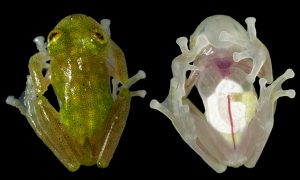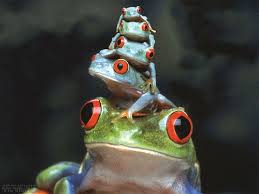Homo Sapiens
The last animal I have decided to write about is one that most people do not even consider an animal, but something higher than. This species has managed to colonize each continent and even go off the planet even though it does not possess any great physical defense. The animal that I am talking about of course is the modern human. Most people do not consider us to be humans even though that is exactly what we are. We reproduce, get our nutrients, have similar anatomy, and have similar problems like disease just like most animals but for some reason popular culture has made the use of the word animal to not be equated with humans as well. Humans are coelomate organisms which means that they have a fluid filled space other than the gut in their internal anatomy. They reproduce sexually and are dioecious which means that they have separate sexes. Humans are vertebrates which means they do have an internal skeleton. Humans have great power over reasoning, logic, and communicate to a great capacity. This has allowed them over thousands of years to make an interconnected community that spans the globe. This has happened because humans were able to create languages that allowed them to articulate their ideas to one another. Using language they were able to create writing to preserve ideas across lifetimes, so that knowledge could be built upon. What really started all of this though is that humans were able to create their own food supply, and stop relying on natural resources through farming. This allowed humans to create societies and begin working on things other than simply surviving by getting food. Humans move through a neuromuscular system. They have a complete digestive system. Humans are omnivores so they eat both animal and plant matter. Humans are very unique in the fact that they are able to impact the world so much. They have been able to change the world to fit their needs, instead of adapting to fit the changes that occur in the world. That is what really sets them apart from other animals, and is how they have been able to spread out so far even though they have no physical adaptations that make them threatening or well adapted to survive in certain places. Humans also have almost no predators, and are able to kill most animals that kill them, so they are a top predator even though they have no adaptation like those of other top predators such as large teeth, claws, massive strength, or great speed and dexterity.

stelleroidea
This next post will be a little different since it will not be focusing on a single species but rather a type of organisms within a class. This class is stelleroidea and the group from that I will be focusing on in that class is the sea stars. Sea stars are in the phylum Echinodermata. The name of this phylum literally means spiny skin which is true for the sea stars. They have five arms and a radial pentamerous symmetry pattern, which means that it can be put five ways to form two symmetric halves. The ecological role of the sea star is that it is a predator. It feeds mostly on barnacles and other invertebrates. The sea star itself is an invertebrate which means it has no spinal structure even though it still seems hard and has a definite shape. This is because it has structures that give support to it made out of calcium carbonate called ossicles. The sea star has two stomachs. The stomach closer to the mouth is called the cardiac stomach and can be protruded out of the mouth to start external digestion for larger prey. The second stomach is called the pyloric stomach and extends into the arms. This has two uses, it increases the surface area of the stomach for increased breaking down of organic material and it serves to distribute nutrients throughout the body. Something weird about a sea star is that it doesn’t use its arm to move. alternatively, it uses tube feet that are controlled by ampulla that contract to fill the tube feet with water so that contracting different tube feet that are all over the bottom surface will move the organism along a substrate. The sea star also has appendages called pedicellariae which remove material from the surface of the body. The sea star is also considered a keystone species which means that it has a large impact on the diversity of an ecosystem even though it may not have the most biomass within that ecosystem. It has this impact by eating its prey (a species of barnacle) which if left unchecked will outcompete most other species in the intertidal zone decreasing diversity drastically.

Factzoo. (2015). Starfish – sea star, armed sea critter. Retrieved December 7, 2016, from http://www.factzoo.com/invertebrates/starfish-sea-star-armed-sea-critter.html
Pelomedusa subrufa
The next species that I have decided to write about is a amphibian that most people would recognize. This species has the binomial nomenclature Pelomedusa subrufa. It has the common name african helmeted turtle. It is a species of turtle that is omnivorous. The length of the shell is about 15cm. The turtle is brown colored. The animal is vertebrate so it has a backbone. The animal is triploblastic and is a coelomate so it has a coelomic space. The turtle has a shell which is used to protect it from predators. This turtle species also produces an unpleasant odor that makes it undesirable for consumption by predators. There is some sexual dimorphism with the female having a broad shell and short tail while the male has a longer tail and a narrower shell. They are semi aquatic creatures and are present in most of Africa. The habitat tends to be muddy areas or creeks. During the dry season they will burrow into the bottom of mud pools and remain dormant until the next rainy season. Since they are omnivores they eat both plants and animals including other turtles. Their main diet is meat from small crustaceans, fish, earthworms, and snails. In large groups some may hunt as a pack to bring down larger prey like birds or other reptiles. They tend to be aggressive when eating and will drown their prey before eating it in the water. During mating season males will follow females and extend their head onto their back to try and initiate mating. If this does not work they will bite the back legs of the female until they are able to mate. Females will lay about 14 eggs which are covered in slime and placed in a nest to hatch.

References
Compton, C. (2014, June 21). 10 bizarre turtle species. Retrieved November 28, 2016, from http://listverse.com/2013/09/17/10-bizarre-turtle-species/
Javaid, K. (2009, August). African helmeted turtle. Retrieved November 28, 2016, from http://explore-biology.blogspot.com/2009/08/african-helmeted-turtle.html
Turritopsis dohrnii
The next animal that I have decided to write about is one that has gotten around something that most people fear and worry about often. This is a jellyfish with the scientific nomenclature Turritopsis dohrnii. This species has found a way to avoid death and is biologically immortal. At least in a sense this is true. When the jellyfish is an adult and comes under extreme stress such as an injury it will transform into an earlier stage that releases multiple copies of the same genetically identical jellyfish as juveniles. Since it is not going through its normal channel fo sexual reproduction which would include making gametes and fertilizing an egg, it can be said that the same individual is reverting to an earlier stage of its life cycle to live again. The life cycle of jellyfish involves multiple stages. The first stage is a fertilized egg that hatches into a planula that is free swimming for dispersal. The planula will then find a place to attach and become a polyp. The polyp will go through a process known as strobilation which will produce several genetically identical copies of itself as juvenile jellyfish that will then grow to be adult jellyfish once they are producing gametes. So in a way it can be said that it is immortal, but an argument can be made that it is going through asexual reproduction in a way. Jellyfish are invertebrates meaning that they have no bone structure but move by jet propulsion out of their mouth. Jellyfish also have stinging cells called cnidae which is why jellyfish are considered poisonous since the cell contains a toxin. This particular jellyfish is about 4.5mm or 0.18in across. It also has up to 90 tentacles. The jellyfish only has one opening to the digestive system. The organism is distributed around the world’s oceans. To eat the organism will stun prey with the cnidae on its tentacles and then bring the food to its mouth where it will be digested and any undigested prey will either be digested intracellularly or excreted out the mouth.
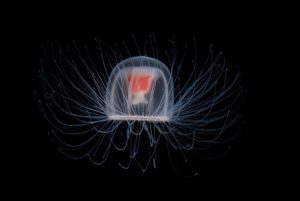
References
AMNH. (2015, May 4). The immortal jellyfish. Retrieved November 15, 2016, from http://www.amnh.org/explore/news-blogs/on-exhibit-posts/the-immortal-jellyfish/
Murai, T. (n.d.). [Turritopsis dohrnii, the so-called “immortal jellyfish,” can hit the reset button and revert to an earlier developmental stage if it is injured or otherwise threatened.]. Retrieved November 15, 2016, from http://www.amnh.org/explore/news-blogs/on-exhibit-posts/the-immortal-jellyfish/
Loxodonta africana
The next animal that I have decided to write about is the largest land mammal on Earth with the scientific nomenclature Loxodonta africana. This animal is the African elephant. The African elephant can grow to be about 8 to 13 feet tall. The elephant can also weigh between 2.5 to 7 tons. Since it is so large it is also a prodigious eater consuming about 300 pounds of food a day. The elephant has a rather unique limb called the trunk which is actually a long nose used for drinking, grabbing, and moving. The elephant also has tusks that are used to dig, find food, and fight at least in males. they are herbivores and so eat vegetation including the wild grasses that are so present in the African savannah. The females of the species live together in herds that can consist of as much as 100 elephants. The largest and oldest female is usually the leader called the matriarch. The males of the species tend to be more solitary. The animals go through sexual reproduction with internal fertilization. The gestation period is the longest of the mammals at about 22 months or two years. The babies are called a calf and weigh about 200 pounds and are about 3 feet in height when they are finally born. The herd cares for the young and protects them. Elephants are known to be extremely intelligent with many emotions. They also have a long memory over years that they use to remember routes to watering holes as they go nomadically around the savannah. Since they live in such a hot environment it is not unusual to see elephants “showering” by blasting themselves with water through their trunks. Afterward, they usually put dirt on their skin in order to protect it. There is also evidence that the elephant can communicate over long distances by creating a sub-sonic rumble that other elephants can feel in their skin. Elephants are close to being endangered since they have been hunted for their tusks which contain ivory used in many man-made products. Without the protections that are in place now banning the hunting of elephants for their tusks they would certainly be endangered and maybe instead of being almost endangered they would be almost extinct.
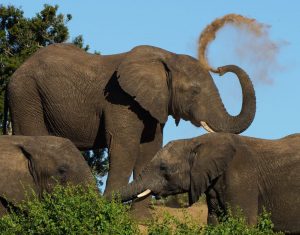
References
Defenders of Wildlife. (2016, September 19). Basic facts about elephants. Retrieved November 14, 2016, from http://www.defenders.org/elephant/basic-facts
National Geographic. (2016, November 02). African elephant national geographic. Retrieved November 14, 2016, from http://www.nationalgeographic.com/animals/mammals/a/african-elephant/
Sommer, J. (2012, November 25). Sand shower [Two young elephants playing while another sprays sand onto its skin.]. Retrieved November 14, 2016, from http://yourshot.nationalgeographic.com/photos/4178436/
Canis lupus
The next animal that I have decided to write about is a large predator that is probably familiar to most people with the scientific name Canis lupus. The animal that I am referring to is the gray wolf. Wolves are predators that had been hunted to near extinction at least in the wild around the 1930s. These animals as much as a nuisance they are on some human lives by eating domestic animals have many positive effects of their predation so that they were reinstituted into environments including Yellowstone national park. Wolves grow to be about 50 to 80 inches in length and about 40 to 175 pounds. Wolves also have a range of colors from brown to gray to black. They tend to be a little larger than the average dog. Wolves are social animals and tend to be a part of a pack with about 6-8 members. Wolves are also territorial and tend to define that territory through group howling. Packs tend to be very structured with a male and female alpha that control where the pack makes a den and hunting patterns. Howling is used within a pack to tell other members where they are in relation to the pack or to tell other wolf packs where the wolves territory is. Each wolf has a unique howl like a human fingerprint in order to tell individuals apart. Wolves are mammals so they can regulate their own temperature. Wolves also reproduce through sexual reproduction with internal fertilization. oftentimes it is only the alphas who will mate and reproduce. The entire pack will care for the baby wolves who are born sightless and defenseless. The pack will watch over them and bring them food until they are able to hunt for themselves. The gestation period for wolves is about 63 days with a litter size of 4-7 pups. Mating season is late January to March. Wolves prefer to hunt elk, deer, and other large hoofed animals, in so doing they keep those populations down which has many beneficial effects for other animals and many plants. These effects can range from keeping species from being eaten or providing food for other animals species.
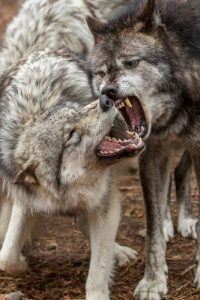
References
Banfield, D. (2014, March 29). I’m the boss [A pack leader showing who is in charge]. Retrieved November 14, 2016, from http://yourshot.nationalgeographic.com/photos/3313851/
Defenders of Wildlife. (2016, September 19). Basic facts about gray wolves. Retrieved November 14, 2016, from http://www.defenders.org/gray-wolf/basic-facts
National Geographic. (2016, November 09). Gray wolf national geographic. Retrieved November 14, 2016, from http://www.nationalgeographic.com/animals/mammals/g/gray-wolf/
Sepia officinalis
The next animal that I have chosen to write about is an invertebrate that is pretty smart. It is a species of cuttlefish with the scientific name Sepia officinalis. the more common name for this species is the European cuttlefish because its habitat is the Mediterranean, North, and Baltic seas. The cuttlefish is a cephalopod from the phylum Mollusca. This species has a lot of cephalization meaning that it has many clusters of sensory organs near its head. The cuttlefish has even been documented to have good learning abilities. It is an invertebrate meaning that it has no internal skeletal structure, but since it is aquatic it does not need one as the density of the water is able to provide support for its structure. It moves by jet propulsion but also uses the fins on the sides of its mantle to swim. It has eight long arms and two long tentacles that are used for prey capture and can be retracted completely inside of the body. It also has an internal shell called the cuttlebone that helps it to stay buoyant, because it can fill or empty of gas depending on its needs. It is a predator that eats mainly fish and crustaceans. The primary predators of the cuttlefish are sharks, dolphins, seals, and large fish. The cuttlefish reproduces sexually. There is a lot of fighting over females, and the males use bioluminescence to impress females. When a mate is chosen they line up head to head and the male transfers his sperm into the females mouth, which she then stores in a pouch under her mouth. The female then goes to lay the eggs and can choose which sperm to use if there was more than one male that she mated with. Cuttlefish die soon after reproduction. The most interesting thing about these organisms is their defense mechanisms. Not only can they ink like an octopus to distract and confuse predators, but they can also camouflage themselves at will to evade detection by predators. They are able to camouflage themselves at will due to some cells called chromatophores which are expanded or retracted by muscles to control color. Iridophores and leucophores are also part of the coloring mechanism since they reflect light. They are also able to change their texture using papillae which are muscles that can extend outward from the body or be pulled back in. The effect that this gives is that the cuttlefish can either be smooth or very spiky. Photophores are also present in the camouflage ability and allow the cuttlefish to bioluminescence.
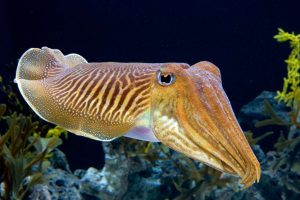
references
Murty, K. R. (n.d.). [Picture of a cuttlefish]. Retrieved October 23, 2016, from http://ilovehomoeopathy.com/sepia-officinalis-2/#.WA0r4pMrJsM
Compton, A. and L. Wiley 2011. “Sepia officinalis” (On-line), Animal Diversity Web. Accessed October 24, 2016 at http://animaldiversity.org/accounts/Sepia_officinalis/
Cyphonia clavata
The next species that I have decided to write about is an insect with a peculiar appendage. The scientific name of the insect is the Cyphonia Clavata. The organism is an insect which also means that it is an invertebrate. Being an invertebrate means that it has no bone structure, but instead has a tough exoskeleton covering to provide structure. This insect is a herbivore. It can use vibrations to send messages to others of its kind on the same host plant. The insect reproduces sexually and the female will inject her eggs into the host plant. The most interesting thing about these insects is there morphology. The insects will actually grow an covering over part of their body that looks like an ant species known to be a tough prey insect. This is a form of camouflage that enables them to use the knowledge that they look like something that is not easily preyed upon to hide from predators. The look of the organism is so that from the top it looks like an ant, but the rest of its body is green and leaf like so that it will blend in with the foliage. The fact that they would use so much energy in producing such an extreme form of camouflage is impressive. This type of growth would be like a human growing another limb on purpose. The fact that this is possible is awe inspiring. That natural selection and evolution would favor such an extreme form of camouflage even with the energy cost is impressive. Scientists do not totally understand how this trait has evolved so that the species can so perfectly grow an imitation of an ant is understandable. Once this is understood however it will most likely help to understand genetic manipulation in such a way that we could mimic this change in other organisms, and maybe one day in humans to produce a new appendage or improve our own appendages. One would think that this kind of evolution would not even be possible, but the fact that it is just speaks to the diversity of our world. If we can think something up then there is probably some form of life that can do it.

References
The ant-mimicking treehopper. (2014, June 29). Retrieved October 17, 2016, from http://www.arkinspace.com/2014/06/the-ant-mimicking-treehopper.html
Davies, E. (2015, November 26). The world’s biggest spider web can span an entire river. Retrieved October 12, 2016, from http://www.bbc.com/earth/story/20151126-the-worlds-biggest-spider-web-can-span-an-entire-river
Deitz, L., & Wallace, M. (2011, August 22). Treehoppers. Retrieved October 17, 2016, from http://treehoppers.insectmuseum.org/public/site/treehoppers/home
La Rue, D. A. (2014, August 8). What is it? an ant-mimicking treehopper: Cyphonia clavata fabricius (membracidae). Retrieved October 17, 2016, from http://crookedbeakworkshop.blogspot.com/2014/08/what-is-it-ant-mimicking-treehopper.html
Than, K. (2010, September 19). Photos: World’s biggest, strongest spider webs found. Retrieved October 12, 2016, from http://news.nationalgeographic.com/news/2010/09/photogalleries/100917-darwins-bark-spider-new-species-spider-webs-madagascar-science-pictures-strongest/
Caerostris darwini
The next species that I have decided to write about is named for the famous naturalist Charles Darwin, who was one of the biologists to describe the theory of evolution. This species is a spider with the scientific name Caerostris darwini. The spider was named for Darwin because it was discovered on the 150th anniversary of when Darwin published On the Origin of Species. The more common name for the species is Darwin’s bark spider. Since it is a spider it is also an invertebrate which means that it does not have a skeleton like ours but a tough exoskeleton. Since it is a spider and a carnivore it also produces venom, but is not fatal to humans. The species has sexual dimorphism which means that the females and males are very different. The females will make webs for their entire lives. The males will stop producing webs once they reach adulthood, even though they made webs as juveniles to focus on reproduction. The females can grow to be about 1in and the males grow to be about 0.25in. The males also have more of a red, black, and white coloring compared to the female black with some white coloring. The spiders are camouflaged to look like bark, and hide on the trees while waiting for insects to fly into their webs. Once an insect gets caught in the web it struggles which moves the silk strands and alerts the spider to the presence of prey. The spider will then go wrap the insect up. It is an orb weaving spider meaning that it produces a web that is circular with lines between, and does not make cobwebs. The spider lives in Madagascar on the rivers there. The interesting thing about these spiders is that even though they have a very minute size, the webs can span entire rivers. One web is known to span a 25m wide river. The spider will send out a large amount of silk that will be carried across the river on the wind and stick to a tree or other anchor, and will then build its web off of that. The large web is extremely taxing in an energy sense. To create that much web costs a lot of energy not to mention building the web as well for such a small spider. The web is able to catch a lot of prey to make up for that failing though, so that there is a lot of source for the energy required for the spider to build a web. The web-building process being energy draining is a cause of concern since the web has to be replaced every couple of days due to tears and loss of consistency and stickiness. The silk that makes this web is about ten times tougher than kevlar. It is able to withstand so much more energy impact before tearing apart or breaking strands. Scientists even hypothesize that the web could potentially catch birds or bats, but no evidence of this has yet been found.
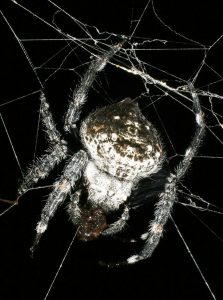
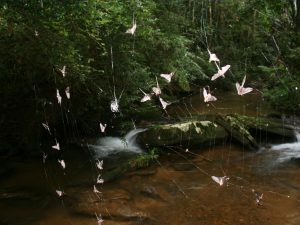
References
Davies, E. (2015, November 26). The world’s biggest spider web can span an entire river. Retrieved October 12, 2016, from http://www.bbc.com/earth/story/20151126-the-worlds-biggest-spider-web-can-span-an-entire-river
Than, K. (2010, September 19). Photos: World’s biggest, strongest spider webs found. Retrieved October 12, 2016, from http://news.nationalgeographic.com/news/2010/09/photogalleries/100917-darwins-bark-spider-new-species-spider-webs-madagascar-science-pictures-strongest/
Hyalinobatrachium taylori
The next animal that I have chosen to write about is an amphibian with the scientific name Hyalinobatrachium taylori. This is a species of frog that lives in South America, and some parts of mexico. They live around rivers in forests. They live at sea level to about 3,800 meters above. They hide in the vegetation around the rivers including trees. These frogs are nocturnal. They are active at night in order to find food and mate. The males have a certain call that they use when searching for a mate that gets louder when they are more dominant. The call is a short high pitched sound. The males will choose a calling site that is preferable for egg laying so that it is close to the water. Males are extremely territorial, and will sometimes physically fight over calling sites. When another male comes close the call will change to a deeper pitch. The defending male will jump onto the back of the approaching male, who will squirm out of the grasp and find another calling spot. When a female comes over to where the male is calling he will jump onto her back and initiate sexual advances. This lasts for a few hours, and the female will deposit about 20 eggs onto the chosen leaf. The leaf that is chosen will generally be over the river so that it can get water to run over the eggs, and so that when they hatch the larvae will fall into the water. It is hypothesized that the larvae will burrow into the bottom of the river and develop there. The males will then guard the eggs for the night. They may return the next and subsequent nights. During the day the frog will sleep hiding near the river in leaves. The frogs also eat during the night, and consume small insects. The frogs are light green with yellow, white, black, or blue spots. Their appearance is the most interesting aspect of these frogs, and also gives them their nickname of the glass frog. Their dorsal or back side that can be seen by looking down at them from their natural position is green and normal looking, but the ventral or underside is a much different story. The underside of these frogs is transparent, so that the internal organs are visible. This is hypothesized to help with camouflage, which is important for these small nocturnal animals that could be tasty meal for the more abundant species that are active during the day. For people who are against dissection, may also like these frogs since they can still be studied internally without harming the frogs, at least to an extent. Sadly these amazing frogs are also endangered. At least some of the species that fall under the family that make up glass frogs. This is due to habitat destruction through processes like deforestation, which leaves the frogs without a place to hide during the day.
References
Kubicki, B. (n.d.). Glass frog care and information. Retrieved October 4, 2016, from http://www.reptilesmagazine.com/Wild-Amphibians/Glass-Frog-Basics/
Nelson, J. K. (2006, June). Glass frog, hyalinobatrachium taylori. Retrieved October 4, 2016, from https://siteslab.byu.edu/Portals/25/images/Field/FrenchGuiana/GlassFrog_HyalinobatrachiumTaylori.JPG
